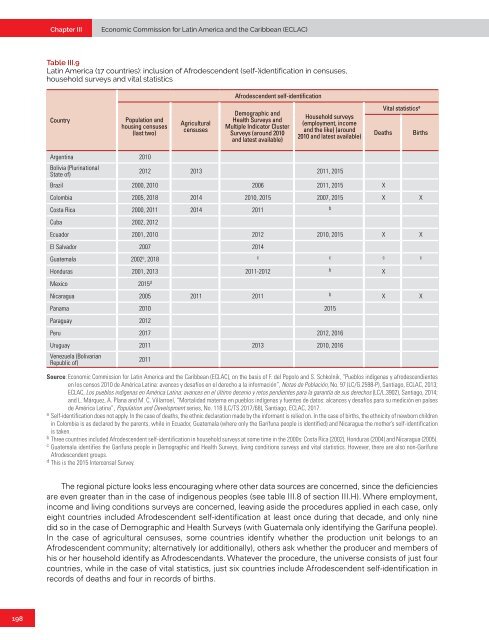Draft first regional report on the implementation of the Montevideo Consensus on Population and Development
This draft report seeks to give an account of progress in the implementation of the priority measures of the Montevideo Consensus on Population and Development in the region, as well as the differences between countries in terms of the degree of implementation. By highlighting relevant national experiences, it also seeks to facilitate the exchange of good practices among countries so that they can benefit from each other in their efforts to advance the implementation of the actions of the Montevideo Consensus.
This draft report seeks to give an account of progress in the implementation of the priority measures of the Montevideo Consensus on Population and Development in the region, as well as the differences between countries in terms of the degree of implementation. By highlighting relevant national experiences, it also seeks to facilitate the exchange of good practices among countries so that they can benefit from each other in their efforts to advance the implementation of the actions of the Montevideo Consensus.
You also want an ePaper? Increase the reach of your titles
YUMPU automatically turns print PDFs into web optimized ePapers that Google loves.
Chapter III<br />
Ec<strong>on</strong>omic Commissi<strong>on</strong> for Latin America <strong>and</strong> <strong>the</strong> Caribbean (ECLAC)<br />
Table III.9<br />
Latin America (17 countries): inclusi<strong>on</strong> <strong>of</strong> Afrodescendent (self-)identificati<strong>on</strong> in censuses,<br />
household surveys <strong>and</strong> vital statistics<br />
Afrodescendent self-identificati<strong>on</strong><br />
Country<br />
Populati<strong>on</strong> <strong>and</strong><br />
housing censuses<br />
(last two)<br />
Agricultural<br />
censuses<br />
Demographic <strong>and</strong><br />
Health Surveys <strong>and</strong><br />
Multiple Indicator Cluster<br />
Surveys (around 2010<br />
<strong>and</strong> latest available)<br />
Household surveys<br />
(employment, income<br />
<strong>and</strong> <strong>the</strong> like) (around<br />
2010 <strong>and</strong> latest available)<br />
Vital statistics a<br />
Deaths<br />
Births<br />
Argentina 2010<br />
Bolivia (Plurinati<strong>on</strong>al<br />
State <strong>of</strong>)<br />
2012 2013 2011, 2015<br />
Brazil 2000, 2010 2006 2011, 2015 X<br />
Colombia 2005, 2018 2014 2010, 2015 2007, 2015 X X<br />
Costa Rica 2000, 2011 2014 2011 b<br />
Cuba 2002, 2012<br />
Ecuador 2001, 2010 2012 2010, 2015 X X<br />
El Salvador 2007 2014<br />
Guatemala 2002 c , 2018 c c c c<br />
H<strong>on</strong>duras 2001, 2013 2011-2012 b X<br />
Mexico 2015 d<br />
Nicaragua 2005 2011 2011 b X X<br />
Panama 2010 2015<br />
Paraguay 2012<br />
Peru 2017 2012, 2016<br />
Uruguay 2011 2013 2010, 2016<br />
Venezuela (Bolivarian<br />
Republic <strong>of</strong>)<br />
2011<br />
Source: Ec<strong>on</strong>omic Commissi<strong>on</strong> for Latin America <strong>and</strong> <strong>the</strong> Caribbean (ECLAC), <strong>on</strong> <strong>the</strong> basis <strong>of</strong> F. del Popolo <strong>and</strong> S. Schkolnik, “Pueblos indígenas y afrodescendientes<br />
en los censos 2010 de América Latina: avances y desafíos en el derecho a la información”, Notas de Población, No. 97 (LC/G.2598-P), Santiago, ECLAC, 2013;<br />
ECLAC, Los pueblos indígenas en América Latina: avances en el último decenio y retos pendientes para la garantía de sus derechos (LC/L.3902), Santiago, 2014;<br />
<strong>and</strong> L. Márquez, A. Plana <strong>and</strong> M. C. Villarroel, “Mortalidad materna en pueblos indígenas y fuentes de datos: alcances y desafíos para su medición en países<br />
de América Latina”, Populati<strong>on</strong> <strong>and</strong> <strong>Development</strong> series, No. 118 (LC/TS.2017/68), Santiago, ECLAC, 2017.<br />
a<br />
Self-identificati<strong>on</strong> does not apply. In <strong>the</strong> case <strong>of</strong> deaths, <strong>the</strong> ethnic declarati<strong>on</strong> made by <strong>the</strong> informant is relied <strong>on</strong>. In <strong>the</strong> case <strong>of</strong> births, <strong>the</strong> ethnicity <strong>of</strong> newborn children<br />
in Colombia is as declared by <strong>the</strong> parents, while in Ecuador, Guatemala (where <strong>on</strong>ly <strong>the</strong> Garífuna people is identified) <strong>and</strong> Nicaragua <strong>the</strong> mo<strong>the</strong>r’s self-identificati<strong>on</strong><br />
is taken.<br />
b<br />
Three countries included Afrodescendent self-identificati<strong>on</strong> in household surveys at some time in <strong>the</strong> 2000s: Costa Rica (2002), H<strong>on</strong>duras (2004) <strong>and</strong> Nicaragua (2005).<br />
c<br />
Guatemala identifies <strong>the</strong> Garífuna people in Demographic <strong>and</strong> Health Surveys, living c<strong>on</strong>diti<strong>on</strong>s surveys <strong>and</strong> vital statistics. However, <strong>the</strong>re are also n<strong>on</strong>-Garífuna<br />
Afrodescendent groups.<br />
d<br />
This is <strong>the</strong> 2015 Intercensal Survey.<br />
The <str<strong>on</strong>g>regi<strong>on</strong>al</str<strong>on</strong>g> picture looks less encouraging where o<strong>the</strong>r data sources are c<strong>on</strong>cerned, since <strong>the</strong> deficiencies<br />
are even greater than in <strong>the</strong> case <strong>of</strong> indigenous peoples (see table III.8 <strong>of</strong> secti<strong>on</strong> III.H). Where employment,<br />
income <strong>and</strong> living c<strong>on</strong>diti<strong>on</strong>s surveys are c<strong>on</strong>cerned, leaving aside <strong>the</strong> procedures applied in each case, <strong>on</strong>ly<br />
eight countries included Afrodescendent self-identificati<strong>on</strong> at least <strong>on</strong>ce during that decade, <strong>and</strong> <strong>on</strong>ly nine<br />
did so in <strong>the</strong> case <strong>of</strong> Demographic <strong>and</strong> Health Surveys (with Guatemala <strong>on</strong>ly identifying <strong>the</strong> Garífuna people).<br />
In <strong>the</strong> case <strong>of</strong> agricultural censuses, some countries identify whe<strong>the</strong>r <strong>the</strong> producti<strong>on</strong> unit bel<strong>on</strong>gs to an<br />
Afrodescendent community; alternatively (or additi<strong>on</strong>ally), o<strong>the</strong>rs ask whe<strong>the</strong>r <strong>the</strong> producer <strong>and</strong> members <strong>of</strong><br />
his or her household identify as Afrodescendants. Whatever <strong>the</strong> procedure, <strong>the</strong> universe c<strong>on</strong>sists <strong>of</strong> just four<br />
countries, while in <strong>the</strong> case <strong>of</strong> vital statistics, just six countries include Afrodescendent self-identificati<strong>on</strong> in<br />
records <strong>of</strong> deaths <strong>and</strong> four in records <strong>of</strong> births.<br />
198


















